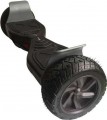Range
The average distance that can be driven on a single battery charge. Usually, the range is indicated with some overestimation — based on a low (optimal from the point of view of energy consumption) speed, uniform movement on a flat surface, etc. Therefore, the actual battery life may be somewhat less. Nevertheless, this parameter is quite suitable for comparing different models with each other.
Thanks to the development of technology, the range in modern self-balancing vehicles can reach
several tens of kilometers.
Max. speed
The maximum speed that the hoverboard is capable of reaching: on a flat surface, with a full battery charge and an average rider weight. The same parameter is also the maximum safe speed allowed when using this model; in theory, it is possible to accelerate even faster (for example, from a mountain), but this is fraught with breakdown, accident and injury, and therefore is not recommended at all.
Most modern models have a maximum speed of up to 20 km/h, and in “high-speed” vehicles this figure can exceed 30 km/h. Note that a fall from a hoverboard, even at a speed of 10 – 15 km/h, is fraught with serious injuries. Therefore, protective gear is highly recommended.
Max. climb angle
The maximum angle of inclination of the surface at which the vehicle can normally drive up or down (in some models, this parameter is indicated only for one direction, for example, up).
This parameter characterizes the ability of the device to overcome ups and downs. In modern models, it can reach 45 °. At the same time, note that the ability to cope with large angles requires not only powerful motors, but also appropriate design features (in particular, so that the protective cover does not scrape the ground); and for the descent, the second is even more important than the first. Therefore, when choosing a model for frequent driving on slopes, you should pay attention not only to power, but also to the angle of inclination directly stated in the specs.
Also note that at a high load (approaching the maximum), the efficiency of overcoming climbs may decrease. On the other hand, some manufacturers indicate the angle of inclination at the maximum load, and clarify that the light weight of the rider allows you to overcome steeper climbs than originally stated.
More features
—
Position lights. The dimensions of the self-stabilizing transport are small, so such lights not only highlight the dimensions of the vehicle, but increase its visibility. This function is especially important at night — for safety, both for the rider and those around him. And in some countries, operation without position lights is prohibited by law.
In models that do not have front and rear sides as such and can drive equally efficiently in either direction, position lights are often made in the form of switchable two-colour lights: for example, the device turns on white light from the side it is currently traveling to, and red on the opposite side of the case.
— Bluetooth. This feature turns the vehicle into a mobile speaker system: you can connect an external Bluetooth device (for example, a smartphone) to it and listen to music through the
built-in speakers during the ride.
—
USB port. Usually, this port is intended for charging smartphones or other gadgets from the built-in battery — thus, the vehicle turns into an external battery (power bank). At the same time, given the impressive battery capacity in a self-stabilizing vehicle, charging an external gadget has practically no effect on the power reserve — especially since we are most often talking about a minimum charge replenishment, and not about charging up to 100%.
...— Remote control. Such control can be carried out both from a separate remote control supplied in the kit, and via a smartphone (usually via Bluetooth) using a proprietary application. Specific control options can be different — up to the tracking mode, when the device itself follows the owner at a certain distance. However, anyway, this function significantly expands the possibilities of transport.Full charge time
The time required to fully charge the battery from zero to full capacity. This parameter allows you to estimate how long the breaks should be for a full replenishment of the energy supply. Reducing the charging time makes the use of the device more convenient, but it is achieved through special technologies, which, usually, are not cheap.

